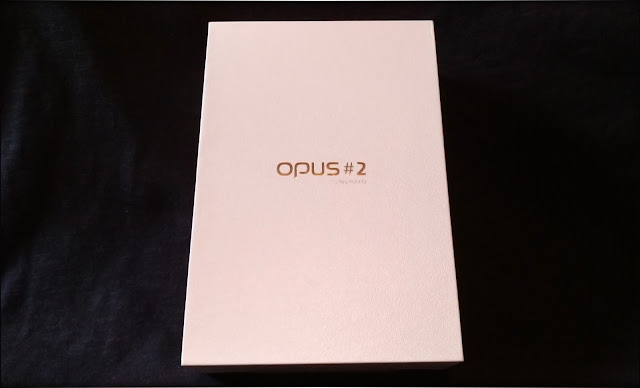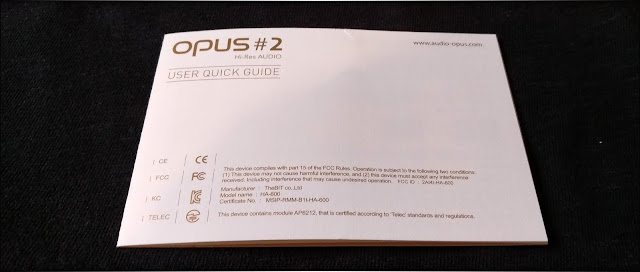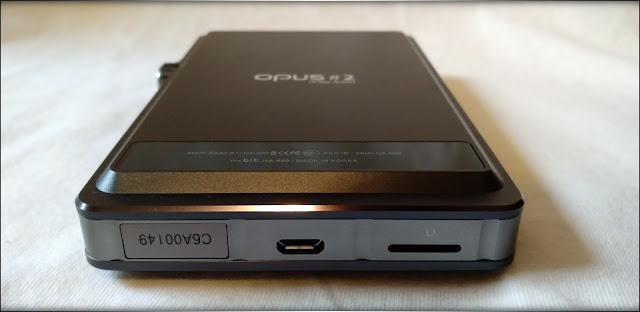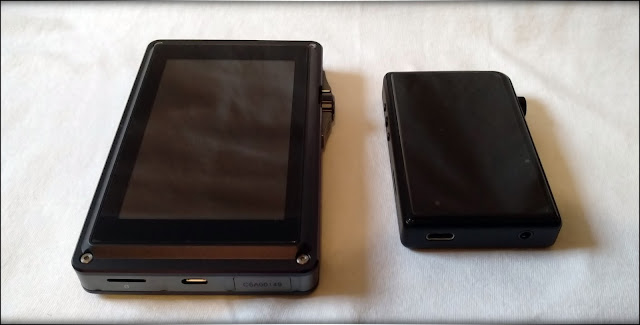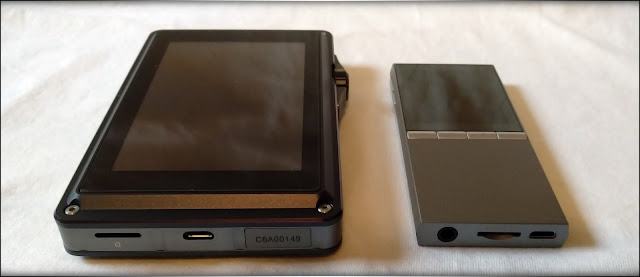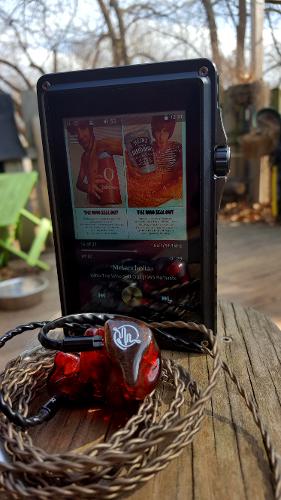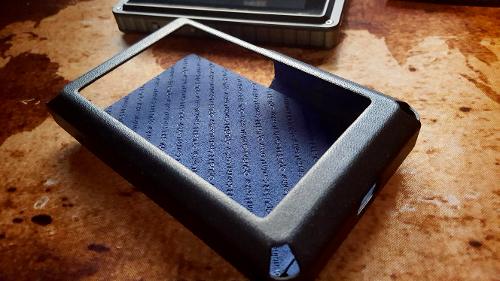Opus#2 Dap Review
- Expatinjapan

Opus#2 and Campfire Audio Vega
Opus#2 dap review
-expatinjapan

Opus#1 review
https://headpie.blogspot.jp/2016/07/the-bit-opus1-dap-review-expatinjapan.html
Opus#3 review
https://headpie.blogspot.jp/2017/06/the-audio-opus-opus3-dap-review.html
"Hi-Res Portable DAP Opus#2 is a brand new total solution for audiophiles who possess high expectations and great anticipation from available Hi-Res audio players in terms of sound quality and overall performance." -TheBit
Unboxing and build



The Opus#2 comes with a protective screen factory installed


Body : Aluminum [Full Metal Body]
Display : 4” IPS Touch Display (480*800)
Dimensions : 76mm(W)*124mm(H)*18.3mm(D)
Weight : 252g

Micro SD card slot and micro usb charge port
*There are reports on Head-fi of 256GB and 512GB cards working-

Power on/off button, balanced and single ended jacks. FF, play/pause, REV buttons
"Control buttons are ergonomically designed and positioned to provide
a full control over the device holding it in one hand."

"Volume control wheel is very smooth and comfortable to handle as well as very detailed to reach
that necessary level of volume. 1-150 volume steps may be controlled without turning screen on."

"Power On/Off button is ideally located to switch on and off the device with only one finger.
Power button is also used to wake your set up from the Sleep mode."

Once again a beautiful case to protect your Opus device.

I find the side buttons (FF/PP/REV) which don't protrude much when in the case
to be tactile enough to use whilst in my hand or pocket

"Bit to Bit Decoding & High Definition Audio Files Playback
Opus#2 Portable DAP has an outstanding performance in Native DSD Playback as well as Hi-Res Audio files up to 32bit/384kHz. The best Sabre 32(ES9018K2M) Real Dual DAC will provide the clearest and brilliant sound." -TheBit


Case and charger cable
Specifications
Core Specs:
-Native DSD Playback
-32bit / 384kHz High Resolution Sound
-4” Touch display (IPS panel)
-SABRE32 ES9018K2M x 2EA Dual DAC
-ARM Cortex-A9 1.4GHz, Quad-Core CPU DDR3 1GB
-Internal Memory 128GB (External Micro SDcard up to 200GB)
*There are reports on Head-fi of 256GB and 512GB cards working-
-Full Metal Body (Aluminum CNC)
-WI-FI : 802.11 b/g/n (2.4GHz)
-Bluetooth V4.0(A2DP, AVRCP)
-Ultra Power Saving Mode

All specs:
-Model Opus#2(HA-600)
-Manufacturer/Origin the bit/Korea(2016)
-Body Material Aluminum (FULL METAL BODY)
-Display 4″ TFT Touch Display(480*800)
IPS PANEL
-Dimensons 76mm(W) * 124mm(H) * 18.3mm(D)
-Weight 252g
-CPU & MEMORY ARM Cortex-A9 1.4GHz, Quad-Core
MEMORY(RAM) : DDR3 1GBYTE
-Button BUTTON: POWER, PLAY/PAUSE, FF, REW VOLUME(WHEEL)
-Supported Audio Formats WAV, FLAC, ALAC, AIFF, WMA,
MP3, OGG,APE(Normal, High, Fast)
native DSD(DFF,DSF)
-Sample rate PCM : 8kHz ~ 384kHz (8/16/24/32bits per Sample)
/ DSD Native: DSD64(1bit 2.8MHz), Stereo/ DSD128(1bit 5.6MHz), Stereo
-EQ & Effect EQ:10Band NORMAL/USER1/2/3
-Input USB Micro-B input (for charging & data transfer (PC & MAC))
/ Connection Mode : MTP (Media Device)
-Outputs PHONES (3.5mm) / Optical Out (3.5mm) /
Balanced Out(2.5mm, 4-pole support)
-Wi-Fi 802.11 b/g/n (2.4GHz)
-Bluetooth V4.0 (A2DP, AVRCP)
-Feature Enhancements Firmware upgrades supported (OTA)
-Battery 4,000mAh/3.7V Li-Polymer
-Battery Life (Play) Time & Charge Time
Play: Approximately 9.5 hours.
Charge:4 hours
-Memory Built-in 128G
External microSD*(Max 200GB)Supports SDXC exFAT,NTFS
*There are reports on Head-fi of 256GB and 512GB cards working-
-Clock source/ Jitter 50ps(Typ)
-OS Android 5.1.1
-Supported OS Windows 7,8,(32/64bit), MAC OS x 10.9 and up
-Accessory (Package)
-Audio Performance
-DAC ESS9018K2M * 2EA (Dual DAC)
-Decoding Support up to 32bit / 384kHz Bit to Bit Decoding
-Frequency Response ±0.02dB(Condition: 20Hz~20KHz) Unbalanced & Balanced
±0.3dB(Condition: 10Hz~70KHz) Unbalanced & Balanced
-Signal to Noise Ratio 115dB @ 1KHz, Unbalnced
116dB @ 1KHz, Balanced
-Crosstalk 130dB @ 1KHz,Unbalanced / 135dB @ 1KHz, Balanced
-THD+N 0.0009% @ 1KHz
-Output Impedance Balanced out 2.5mm(1ohm) / PHONES 3.5mm(2ohm)
-Ouput Level Unbalance 2.3Vrms / Balance 2.5Vrms(Condition No Load)
-Volume Step 150 steps
-Gapless, Remove Silence O

Opus#2 and Meze 99 Neo headphones
Body (again):
-Aluminum [Full Metal Body]
-Display : 4” IPS Touch Display (480*800)
-Dimensions : 76mm(W)*124mm(H)*18.3mm(D)
-Weight : 252g

Nothing Tricky about this smooth volume wheel

Opus#2 and Dita - The Truth (sounds fantastic).

Opus#2 and Campfire Audio Jupiter
Opus#2 Dap and case back

 Photo comparisons between the three Opus models
Photo comparisons between the three Opus models

From the left to right: Opus#1, Opus#3 and Opus#2.



Opus#2, Opus#3 and Opus#1

from top to bottom: Opus#1, Opus#3 and Opus#2






A shot from an earlier review where I utilized all the Opus daps for coherency
Price
Prices of the Opus#2 have been known to vary.
One the official distributors of the Opus daps is Musicteck
https://shop.musicteck.com/products/opus-2-hi-res-portable-digital-audio-player
They have the Opus#2 for sale at US$1,099.00, down from an original $1,599.00.
The Opus#1 retails from US$300 - US$599 .
The Opus#3 retails for US$699 - US$899.
Depending on where one shops.
Opus#1 review https://headpie.blogspot.jp/2016/07/the-bit-opus1-dap-review-expatinjapan.html
Opus#3 review https://headpie.blogspot.jp/2017/06/the-audio-opus-opus3-dap-review.html

Opus#2 and Clear Tune Monitors VS4
Sound

As per usual I got an ample amount of hours on the Opus#2 dap before proceeding with the review.
Files used were mainly FLAC.

The Opus#2 echoes its siblings the #1 and #3 in terms of UI and underlying power, it has similar features to the Opus#3 in having internet connective capabilities and they differ in their DACs.
Off course a DAP is sum of its whole parts and whatever amplifier used also plays a big part.
The Opus#1:
Cirrus Logic CS4398 x 2EA Dual DAC
ARM Cortex-A9 1.4GHz, Quad-Core CPU DDR3 1GB
The Opus#3:
Burr-Brown PCM1792A DAC
ARM Cortex-A9 1.4GHz, Quad-Core CPU & DDR3 1GB
The Opus#2:
SABRE32 ES9018K2M x 2EA Dual DAC
ARM Cortex-A9 1.4GHz, Quad-Core CPU DDR3 1GB
All of the Opus Daps have 2 ohms output impedance on the single ended jack, and 1 ohm output impedance on the balanced jack. I often use multi driver BA IEMs and find I get a truer response and result by using the balanced jack. Those with single dynamic drivers or headphones would generally be ok with either.
So is the secret sauce of the Opus#2 in the dac alone? I truly and honestly don`t know.
I do know that I find all the Opus Daps to be pleasing in their own way (I haven't tried the Opus#1 metal version). As noted earlier I have reviewed the Opus#1 and Opus#3 on Head pie already.

But I can say I think the Opus#2 is above the previous other Opus daps, as the #3 is definitely above the Opus#1 in terms of sound quality.
To quote from the earlier Opus#3 review:
"I found the Opus#3 to be more resolving overall.
The Opus#1 has a vocals forward signature at ordinary volumes, whereas with the Opus#3 seems the music is up with the vocals, making the sound more engaging and richer and there is more definition.
The sound stage on the Opus#3 is much larger than on Opus#1, on height and width. Making the Opus#3 more exciting, intimate and engaging. But its incremental and not absolute.
The Opus#3 sound stage is increased in the width, slightly in the height whilst not much more in the depth.
The sound stage increases when using the balanced out, as does instrument separation.
They both retain the characteristic smoothness of the Opus brand, more so when using the 2 ohm single ended out, things get a bit more apart when using the balanced out.
Instrument separation is cleaner on the Opus#3.
When I turn up the volume louder the Opus#3 seems to cope better with it.
In summary, its very close to call in terms of sonics but the Opus#3 just pulls ahead on the single end, and more so on the balanced out.
In terms of extended listening sessions I would pick the Opus#3 over the Opus#1.
The Burr-Brown dac just adding that extra little something."

So where does that leave us? In earlier uses of the Sabre dacs the implementation was found to be on the bright side. Now days designers seem to have found ways to incorporate them into daps in a more pleasing and balanced fashion. No more of that famous glare we used to read about. And the Opus#2 certainly doesn't suffer from undue brightness.

The Opus#2 departs from the earlier models in its ability to achieve a wide sound stage, in height, width and depth, its speed, effortlessness, detail, neutral transparency and separation.
Highly resolving and detailed without using any tricks of boosted treble.
The Opus#2 veers slightly onto a warm edge at times, but my emphasis is on slightly, If anything it gives a sense of fullness, of weight and gravity.
It comes across as neutral, transparent and all those other goody good good audio buzzwords we like to hear and read being bandied about. But the Opus#2 is the real deal in this matter.
The separation, detail and resolution are truly stunning.

I haven't dithered too much in this review, which I usually do when I am not sure about gear I am reviewing, or If it hasn't hit my sweet spot - regardless of price or personal audio signature preferences.
The Opus#2 is an item I am truly impressed by and enjoy using. The ease of its UI, the beautiful neutral to reference quality of its performance. The naturalness and musicality that doesn't sacrifice detail, speed, clarity and resolution. The graceful separation which creates and intimate listening space. A sound stage that reaches far into the ether, 'an infinite sphere, whose centre is everywhere and whose circumference is nowhere'.
Now I may have delved into pontification and a poor sense of poetic license, yet I stand by my words. The Opus#2 belongs on the top shelf with the other TOTL daps.
 User interface
User interface
A quick look.
The main screen can be seen in the many photos of the Opus#2 within this review.

The usual Android drop down menu.

Settings menu.




Songs, Albums, Artists, Genre, Folders, Favorites, Playlists.


Size

The Opus#2 fits into ones hand comfortably.
Overall
The Opus#2 is a stellar offering from the already competent stable of daps thebit/audio-opus also produces.
Being the second portable dap of the series Opus#1, Opus#2 and then Opus#3 (not to mention the metal version of #1), the Opus#2 is their higher end dap.
In terms of the build it is robust, solid, not too weighty, fits well in the hand, not over sized.
The volume wheel functions well and has many steps with which to control the volume to pinpoint levels, and has a lovely click, click, click to it.
The side buttons are raised just enough so that one doesn't accidentally pause, fast forward or reverse. Sometimes I think I would have liked them a little bit more raised so that one can feel them more when the case is on, at other times they seem satisfactory.
The case is well made, and fits like a glove.
Its UI like the other Opus daps is very easy to use and navigate. The UI is similar If not identical across the three daps. So familiarity with one means you can step right into the other audio-opus product with ease.
With 128GB on board storage, a decent and fast processor, ESS dac, wifi connectivity, an excellent sleep mode and more. The Opus#2 certainly has it all.
*There are reports on Head-fi of 256GB and 512GB cards working-
Sound is neutral towards reference with a hint of warmth here and there at times, it packs detail and resolution with a deep depth of musicality that at no times alters its intent as an accurate player. The instrument separation is brilliant, and with a sound stage that doesn't disappoint.
The Opus#2 is a dap that handles all music I have thrown at it with ease, It stands on the shoulders of the previous quality offerings by Opus.
I have no regrets when I take it on my daily commute and pair it with a TOTL set of IEMs.
As I reach the end of this review I am listening to the delicate track 'Corpus Christi Carol' by Jeff Buckley from the album Grace...and it is sublime.
And then Slayer - 'Reborn' comes on, handled superbly. And I smile.

Thank you to thebit/Audio Opus for sending the Opus#2 dap to Head pie for review





